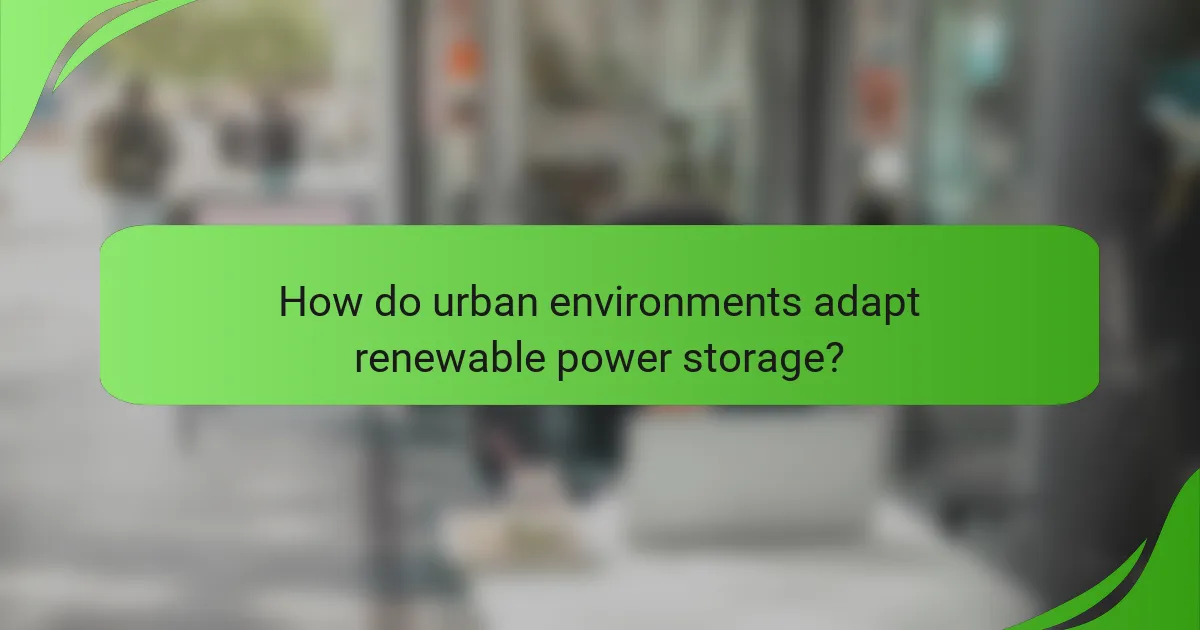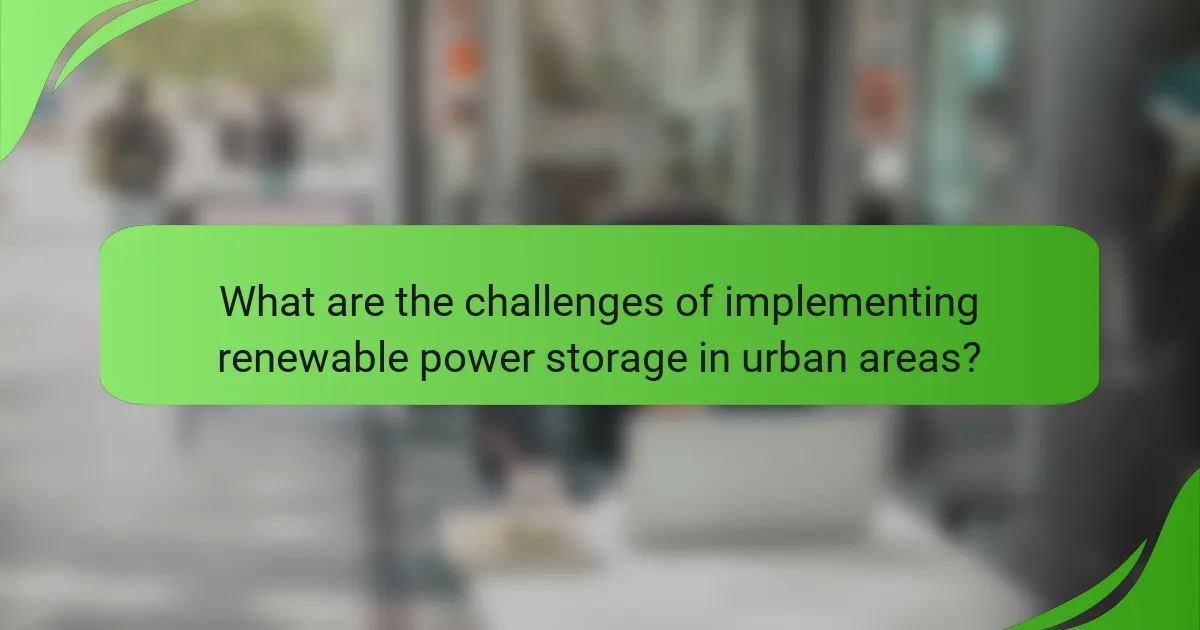As urban areas increasingly turn to renewable energy, effective power storage solutions become essential for managing energy supply and demand. Options such as battery energy storage systems, pumped hydro storage, and thermal energy storage are tailored to meet the unique challenges of urban settings, including space limitations and efficiency needs. By integrating advanced technologies and community initiatives, cities can enhance energy reliability and sustainability, paving the way for a greener future.

What are the best renewable power storage solutions for urban environments?
The best renewable power storage solutions for urban environments include battery energy storage systems, pumped hydro storage, flywheel energy storage, thermal energy storage, and hydrogen storage solutions. Each option has unique characteristics that make it suitable for urban settings, balancing efficiency, space constraints, and cost-effectiveness.
Battery energy storage systems
Battery energy storage systems (BESS) are widely used in urban areas due to their scalability and flexibility. They store energy from renewable sources like solar and wind, allowing for energy use during peak demand times. Common battery types include lithium-ion and flow batteries, which can provide quick response times and high efficiency.
When considering BESS, evaluate factors such as capacity, discharge time, and lifecycle costs. Urban installations often require systems that can fit in limited spaces while providing sufficient energy output, making modular designs particularly appealing.
Pumped hydro storage
Pumped hydro storage is a well-established method that utilizes two water reservoirs at different elevations. During low energy demand, excess energy is used to pump water to the upper reservoir. When demand increases, water is released to generate electricity. However, this solution requires significant space and suitable geographical features, making it less common in densely populated urban areas.
For cities with nearby natural water sources, pumped hydro can be an effective way to store large amounts of energy. Consider local regulations and environmental impacts when planning such projects, as they can affect feasibility and public acceptance.
Flywheel energy storage
Flywheel energy storage systems use kinetic energy stored in a rotating mass to provide quick bursts of power. They are particularly effective for applications requiring rapid response, such as stabilizing grid frequency or providing backup power. Flywheels are compact and can be installed in urban settings with minimal footprint.
While flywheels offer high efficiency and long cycle life, their initial costs can be higher than other storage options. Evaluate the specific energy needs and response time requirements of your urban application to determine if flywheel storage is a suitable choice.
Thermal energy storage
Thermal energy storage systems store excess energy in the form of heat or cold for later use. Common methods include molten salt storage for concentrated solar power and chilled water systems for air conditioning. These systems can help balance energy loads in urban environments, particularly in buildings with high heating or cooling demands.
When implementing thermal storage, consider the integration with existing HVAC systems and the potential for district heating solutions. This approach can enhance energy efficiency and reduce reliance on fossil fuels in urban areas.
Hydrogen storage solutions
Hydrogen storage solutions involve producing hydrogen through electrolysis using renewable energy and storing it for later use. This method offers a versatile energy carrier that can be used for electricity generation, heating, or as fuel for vehicles. Hydrogen can be stored in various forms, including compressed gas or liquid, depending on the application.
Urban areas looking to adopt hydrogen solutions should assess infrastructure needs for production, storage, and distribution. Additionally, consider local regulations and safety standards related to hydrogen use, as these can impact project viability and public perception.

How do urban environments adapt renewable power storage?
Urban environments adapt renewable power storage by integrating advanced technologies and community initiatives that enhance energy efficiency and reliability. These adaptations focus on maximizing the use of available space and resources while ensuring that energy systems are resilient and responsive to local needs.
Integration with smart grids
Smart grids play a crucial role in urban renewable power storage by enabling real-time communication between energy producers, consumers, and storage systems. This integration allows for better management of energy supply and demand, optimizing the use of renewable sources like solar and wind.
By utilizing smart meters and sensors, cities can monitor energy usage patterns and adjust storage strategies accordingly. This can lead to reduced energy costs and improved grid stability, particularly during peak demand periods.
Use of rooftop solar panels
Rooftop solar panels are a practical solution for urban renewable power storage, allowing buildings to generate their own electricity. This localized energy production can significantly reduce reliance on the grid and lower electricity bills.
In many cities, incentives such as tax credits or rebates are available for installing solar panels, making them more accessible. Additionally, pairing rooftop systems with battery storage can provide backup power during outages and help balance energy use throughout the day.
Community energy storage initiatives
Community energy storage initiatives involve shared storage systems that benefit multiple households or businesses within a neighborhood. These projects can enhance energy resilience and reduce costs by pooling resources and maximizing the use of renewable energy.
Examples include community solar gardens or battery banks that store excess energy generated during sunny days for use during peak hours. Such initiatives often receive support from local governments or non-profits, making them an attractive option for urban areas looking to enhance their renewable energy capabilities.

What are the benefits of renewable power storage in cities?
Renewable power storage in urban environments offers significant advantages, including cost savings, improved grid reliability, and reduced environmental impact. These benefits can enhance the overall efficiency of energy systems and contribute to sustainable city development.
Reduced energy costs
Implementing renewable power storage can lead to lower energy costs for consumers and businesses. By storing excess energy generated during peak production times, cities can reduce reliance on expensive peak-time electricity and lower overall utility bills.
For instance, battery storage systems can store solar energy generated during the day for use during the evening when demand is higher. This shift can save urban residents and businesses a considerable amount on their energy expenses, often in the range of 10-30% depending on local electricity rates.
Enhanced grid stability
Renewable power storage plays a crucial role in enhancing grid stability by providing backup power during outages and balancing supply and demand. Storage systems can quickly release energy when there is a sudden spike in demand or when renewable sources are temporarily unavailable.
In cities, where energy demand can fluctuate significantly, having storage solutions like lithium-ion batteries or pumped hydroelectric systems can help maintain a steady power supply. This stability is essential for critical infrastructure and can prevent blackouts, ensuring that essential services remain operational.
Lower carbon emissions
Utilizing renewable power storage contributes to lower carbon emissions by maximizing the use of clean energy sources and reducing dependence on fossil fuels. By storing and using renewable energy, cities can significantly decrease their overall greenhouse gas emissions.
For example, integrating storage with solar and wind energy systems allows cities to utilize more renewable power instead of relying on natural gas or coal during peak times. This shift can lead to reductions in emissions by tens of percent, aligning with global climate goals and improving air quality in urban areas.

What are the challenges of implementing renewable power storage in urban areas?
Implementing renewable power storage in urban areas faces several key challenges, including limited space, regulatory hurdles, and high initial costs. These factors can significantly impact the feasibility and efficiency of energy storage solutions in densely populated environments.
Space limitations
Urban areas often have limited physical space available for renewable power storage systems. This constraint can restrict the size and type of storage technologies that can be deployed, such as batteries or pumped hydro storage. Solutions like vertical storage systems or integrating storage into existing infrastructure can help maximize available space.
Additionally, rooftop installations or underground facilities may be considered, but these options require careful planning and may involve higher costs. Urban planners must evaluate the best locations for these systems to ensure they meet energy demands without disrupting city life.
Regulatory hurdles
Regulatory challenges can impede the implementation of renewable power storage in cities. Local zoning laws, building codes, and safety regulations often dictate where and how storage systems can be installed. Navigating these regulations can be time-consuming and may delay project timelines.
Engaging with local authorities early in the planning process is crucial. Developers should ensure compliance with existing regulations and advocate for policy changes that support the integration of renewable energy storage solutions in urban settings.
High initial costs
The initial investment required for renewable power storage systems can be substantial, often deterring potential projects. Costs can vary widely based on technology, scale, and installation complexity, with some systems requiring significant upfront capital. Financial incentives, such as grants or tax credits, can help mitigate these costs.
Investors and city planners should conduct thorough cost-benefit analyses to understand the long-term savings and environmental benefits. Exploring partnerships with private companies or leveraging public funding can also alleviate financial burdens and promote sustainable energy initiatives in urban areas.

What factors should be considered when choosing a renewable power storage solution?
When selecting a renewable power storage solution, key factors include energy capacity, local regulations, and environmental impacts. Each of these elements plays a crucial role in ensuring the chosen system meets both operational needs and compliance requirements.
Energy capacity requirements
Energy capacity requirements refer to the amount of energy storage needed to meet demand during peak usage times. This can vary widely based on the size of the installation, the type of renewable energy being stored, and the expected consumption patterns. For urban environments, consider systems that can handle fluctuations in energy use, often requiring storage capacities in the range of tens to hundreds of kilowatt-hours.
It’s essential to assess both daily and seasonal energy needs. For instance, a residential solar setup may only need a few kilowatt-hours for daily use, while larger commercial systems might require several hundred kilowatt-hours to manage peak loads effectively.
Location-specific regulations
Location-specific regulations can significantly influence the choice of renewable power storage solutions. Different regions may have varying standards regarding installation, safety, and environmental impact. In the United States, for example, state-level incentives and regulations can dictate the types of storage technologies that are eligible for subsidies or tax credits.
Before proceeding, check local zoning laws and building codes to ensure compliance. Engaging with local authorities early in the planning process can help identify potential hurdles and streamline approvals.
Environmental impact assessments
Conducting environmental impact assessments is crucial when selecting a renewable power storage solution. These assessments evaluate how the installation may affect local ecosystems, air quality, and community health. Many urban areas require these assessments to ensure that new energy projects align with sustainability goals.
When performing an assessment, consider factors such as land use, potential emissions, and the lifecycle impact of the storage technology. For example, battery storage systems may have different environmental footprints based on the materials used and their disposal methods. Engaging with environmental consultants can provide valuable insights and help mitigate potential negative impacts.
